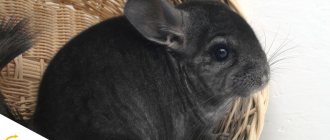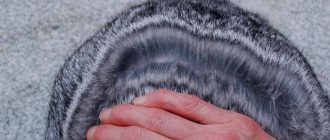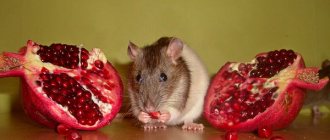Today, chinchilla breeding as a home business is a type of entrepreneurship that has no competitors. Many farmers are interested in raising chinchillas; they ask questions: is it profitable to breed chinchillas, what is needed for business, where to start planning, how to organize the sale of products. Answers to these questions, as well as reviews from experienced entrepreneurs, can be found in this article.
Breeding chinchillas: let's weigh the pros and cons
Advantages of chinchilla business
- This is a relatively free niche in the Russian business sector.
- The demand for our products is constantly growing.
- Good profitability: the cost of maintaining an animal for up to 2 months does not exceed 1 thousand rubles, and the income from each individual is 15 thousand rubles.
- You can start from scratch with minimal effort and without investing a lot of money.
Farm maintenance costs
- Purchase of rodents: at least 10 females and a couple of males (100-150 thousand rubles).
- Home improvement: purchasing equipment (cages and much more can be made with your own hands).
- Food expenses: on average 10 thousand rubles per year per head.
- Electricity costs: light, air conditioning, convector.
- Taxes to the state, state duty for business registration.
- Advertising (may not be required if there are established sales channels).
Comparison with other types of fur-bearing animals
Chinchillas reproduce worse than rabbits and produce no more than 3 cubs in one litter. But chinchilla skin is much more expensive than rabbit skin, because it surpasses it in quality and beauty.
Chinchilla fur is not as durable as mink fur, but a mink coat costs less because it is inferior to a chinchilla coat in several respects: softness, lightness and color range.
Possible risks
- Diseases. The risk of developing the disease in the entire population is very low, since chinchillas have good health and are naturally hardy animals. Serious deficiencies in the care and feeding of pets can lead to an epidemic.
- Lack of distribution channels. This problem will not arise if you think everything through in advance.
Acquisition
The most important part of the business plan is the acquisition of the first animals. For a novice entrepreneur, it will be enough to purchase 10 females and 2 males. This will save costs on starting the project and will allow you to understand the nuances of chinchilla breeding without significant risk.
Healthy purebred specimens of popular coloring cost 6,000 rubles. – 9,000 rub. There are a dozen basic colors of chinchillas:
- White Wilson - very light fur all over the skin and black eyes.
- White velvet - the gray muzzle and paws stand out against a white background.
- White-pink is a slightly darker color than Wilson's White, with pink eyes.
- Beige - has several varieties, from dark to light, with pale eyes.
- Sapphire - light fur with a soft blue tint. This coloration is very difficult to obtain, and the animals subsequently require increased care.
- Purple is the main color closer to gray, with a slight tint.
- The standard color is the natural appearance of chinchillas: dark ash back and light belly.
- Black velvet (corduroy) - black top with a smooth transition to a light bottom, beige nose and black eyes.
- Ebony - varies from dark gray to completely black.
In addition, there are various shades obtained by combining basic ones or as a result of mutations. The most popular are chinchillas with standard coloring or black and velvet.
When choosing adult animals (7-8 months old), you need to pay attention to the following points:
- correct rounded head shape;
- short rounded ears;
- there is practically no neck;
- smooth back without visible thickenings;
- dense and elastic fur, thick over the entire surface of the body;
- weight approximately 600 grams;
- healthy, beautiful producers.
It is best to purchase chinchillas from farms that have been breeding animals for a long time. In a serious farm, management will provide a veterinary certificate and advise on maintenance and care.
Chinchillas naturally have strong immunity and do not need to be vaccinated.
How to organize a business
Purchase of animals and equipment
To start breeding chinchillas at home, you need to purchase the animals themselves and arrange a place for keeping them. For this you will need:
- Cages: 1 cage for 2 rodents, it is recommended to place cages in 2 rows of 6 pieces each, minimum room area – 18 sq.m.
- Drinkers, feeders, hay bowls: nipple drinkers and hanging feeders protect food and water well from contamination.
- Houses and beds: animals need a place for privacy; the size of the bed should not be less than 12 cm in width.
- Filling: Sawdust, shavings or hay.
- Bathing suits and sand: you cannot skimp on sand; the quality of the fur will suffer as a result.
- Toys and exercise equipment for teeth: grinding teeth is vital for rodents; the ideal option is a mineral stone.
- Cleaning and disinfection products: non-toxic specialized products and ultraviolet lamp.
- Convectors: maintaining optimal humidity levels.
- 60 W lamps: per 1 sq.m. 1 lamp required.
- Air conditioning and heater: temperature control.
- Feed and hay.
Business registration
To conduct a business legally, you must register it. Beginning entrepreneurs, if desired, can first register a private subsidiary plot (personal subsidiary plot) and avoid the need to pay taxes. Gradually increasing production volumes, the farmer becomes an individual entrepreneur, and therefore must register the farm with the Federal Tax Service as an individual entrepreneur (individual enterprise). The entrepreneur chooses the type of taxation that is beneficial for him - the Unified National Economic Tax with a rate of 6% of net profit.
In addition to the Federal Tax Service, the business is registered with the local veterinary service.
To run a chinchilla breeding business, you do not need licenses or permits; you only need 2 documents:
- document confirming ownership of the farm;
- registration with the veterinary service.
Equipment
Chinchillas are kept indoors in iron mesh cages 40-45 cm high. On the front wall there is a door, feeders and drinkers. A shelf for resting is attached to the back in the middle; the bottom is lined with pine sawdust. The cages are placed one on top of the other in several tiers and several rows in such a way that animals raised for different purposes are located separately:
- For fur, meat or tribe.
- Increase in livestock.
In addition to cells, you also need to purchase:
- feeders;
- drinking bowls;
- baths for bathing;
- pallets for sawdust;
- heater;
- air conditioner.
All equipment that comes into contact with chinchillas should not be made of wood, since these animals are rodents with very sharp front incisors. The exception is the breeding period, when a box for the young is placed in the cage.
Business plan
A business plan will help you keep everything under control and get the maximum benefit from your new venture.
First, you should start calculating potential profits: from the amount of expected income (calculated by predicting the receipt of offspring), subtract the amount of estimated costs for the preparation and monthly maintenance of rodents.
Approximate costs of maintaining a livestock of 50 chinchillas:
- Chinchillas - 100-150 thousand rubles.
- Cages – 2 thousand rubles X 25 (2 animals per cage) = 50 thousand rubles.
- Feed – 1,000 – 1,500 rubles per day.
- Other expenses (electricity, taxes, veterinary care, advertising, etc.) – 20 – 30 thousand rubles.
- The income from 50 chinchillas is easy to calculate: offspring of 300 puppies per year will bring about 1 million rubles.
When drawing up a business plan, you should take into account that breeding animals cost about $100, which is 2 times more expensive than pets, and the cost of a skin is approximately $80.
Sales of products
Sales channels
Sales of products are possible in three directions:
- breeding animals to other farms;
- skins in studios and factories, as well as at auctions;
- dietary meat can be sold by advertisement or delivered to restaurants;
- small individuals to pet stores.
Beginning entrepreneurs and farmers whose production is constantly growing may need advertising. For these purposes you can use:
- Internet;
- leaflets;
- pet stores.
Do chinchillas eat meat?
Chinchilla meat is eaten, it is dietary and medicinal. It is recommended to be used for cancer, sclerosis and tuberculosis.
Carcasses are sold after the animal is slaughtered for fur.
It is not profitable to specifically raise animals for meat, because even a novice farmer knows how much a rodent weighs—at best, the animal’s weight reaches 1 kg.
Chinchilla weight chart
| Days | Average weight of a chinchilla in grams according to the M.P. table. Pavlova | Average weight in grams Farm table |
| 0 | 41 | 49 |
| 5 | 49 | 59 |
| 10 | 65 | 73 |
| 15 | 72 | 86 |
| 20 | 84 | 101 |
| 25 | 97 | 116 |
| 30 | 114 | 136 |
| 35 | 128 | 154 |
| 40 | 143 | 172 |
| 45 | 158 | 190 |
| 50 | 179 | 215 |
| 55 | 188 | 226 |
| 60 | 201 | 242 |
| 90 | 272 | 327 |
| 120 | 321 | 385 |
| 150 | 362 | 435 |
| 180 | 396 | 475 |
| 210 | 411 | 493 |
| 240 | 422 | 506 |
| 270 | 440 | 528 |
| Adults 505 | Adults 606 |
Nutrition
Chinchillas are fed once a day in the evening, as they are nocturnal. The basis of the diet is balanced granulated food. Additionally, herbs are introduced - fresh and dried, apples, carrots. To maintain immunity and compensate for the lack of fresh air, it is necessary to give vitamin complexes weekly.
An adult animal eats about 50 g of food per day. However, it is necessary to take into account the rather large difference in the weight of animals depending on gender, species and age. Therefore, it is necessary to adjust the dosage for specific individuals.
Particular attention should be paid to the nutrition of pregnant females and young animals. For the first one and a half to two months, the cubs are fed with milk, then they are removed from the mother into a separate cage and given regular food. It is extremely undesirable to change anything in the diet of females and young individuals, as they react sharply to new foods.
Reviews from experienced entrepreneurs
Daria, Pskov region
My parents are breeding chinchillas. They started with a small number of individuals, but then they realized that these animals are very profitable, now they have more than 100 heads. The farm is located right on the plot in a special extension. To maintain the heat at least 18 degrees, a heater was installed; it doesn’t turn on that much. Once they forgot to turn it on, 6 chinchillas died. Animals are not fussy about caring for them, but they need to be fed and watered every day and cleaned regularly. The animals eat little and take up minimal space. Parents sell chinchillas to pet stores and sell them online as pets, since they are not involved in skinning.
Fedor, Saratov
When I decided to start farming, I was looking for a business in which I didn’t need to invest a lot right away. Among my friends who breed animals, there is a chinchilla specialist, he explained everything, and it turned out that chinchillas are what I need. I don’t slaughter them for fur; I mainly sell breeding specimens to beginning farmers in Russia and neighboring countries, and sell the rest to a pet store. I am glad that I chose such a profitable path in farming.
Disadvantages of keeping chinchillas at home
- Chinchillas are nocturnal animals, so you should be prepared for night noises in the cage; you should not place it in the bedroom. When getting this rodent, you should be prepared to hear rustling, eating food, jumping and funny games every night.
- Despite the fact that the cage for such an animal should not be too large, it should also not be too small, especially in terms of height, it should have shelves on which the chinchilla could crawl and jump.
- Rodents also take sand baths; they cannot be prohibited from doing this, because such a procedure is necessary for them; chinchillas are strictly prohibited from swimming in water. Therefore, you will have to clean the area next to the cage; scattered sand will often be found everywhere. Also, at least once a day you will still have to take care of your pet, that is, provide new hay and food, as well as pour fresh water.
- If you decide to let the rodent out for a walk around the apartment, you will need to monitor it very carefully. The point is that chinchillas can eat your furniture, wires, and also get into a place from which you will have to rescue the animal. The owner can turn away literally for a second, and the animal will already find itself in an unpleasant situation.
- It is extremely undesirable for these animals to endure stressful situations, and such for them can be an ordinary loud sound or a sudden movement in front of the cage during the day. Also, not all animals like to be cuddled, so it is not a fact that you will be able to play with your pet every day, but if you pick it up forcibly, this can negatively affect the health of the animal. Also, chinchillas need to be provided with optimal temperature conditions, they do not like heat, the maximum temperature for their life is +26 degrees, but if the temperature in your apartment is higher, then you will have to cool it with an air conditioner.
So, there are pros and cons to keeping a chinchilla at home.








